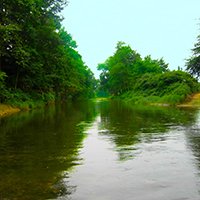Diatom communities and ecological status classification in the upper Po River basin

Submitted: 26 April 2021
Accepted: 7 June 2021
Published: 13 July 2021
Accepted: 7 June 2021
Abstract Views: 879
PDF: 358
Annex 1: 177
HTML: 88
Annex 1: 177
HTML: 88
Publisher's note
All claims expressed in this article are solely those of the authors and do not necessarily represent those of their affiliated organizations, or those of the publisher, the editors and the reviewers. Any product that may be evaluated in this article or claim that may be made by its manufacturer is not guaranteed or endorsed by the publisher.
All claims expressed in this article are solely those of the authors and do not necessarily represent those of their affiliated organizations, or those of the publisher, the editors and the reviewers. Any product that may be evaluated in this article or claim that may be made by its manufacturer is not guaranteed or endorsed by the publisher.
Similar Articles
- Yuanfeng Cai, Fanxiang Kong, Diversity and dynamics of picocyanobacteria and the bloom-forming cyanobacteria in a large shallow eutrophic lake (lake Chaohu, China) , Journal of Limnology: Vol. 72 No. 3 (2013)
- Külli Kangur, Peeter Kangur, Kai Ginter, Kati Orru, Marina Haldna, Tõnu Möls, Andu Kangur, Long-term effects of extreme weather events and eutrophication on the fish community of shallow Lake Peipsi (Estonia/Russia) , Journal of Limnology: Vol. 72 No. 2 (2013)
- Vanessa Virginia Barbosa, Juliana dos Santos Severiano, Dayany Aguiar de Oliveira, José Etham de Lucena Barbosa, Influence of submerged macrophytes on phosphorus in a eutrophic reservoir in a semiarid region , Journal of Limnology: Vol. 79 No. 2 (2020)
- Jean-Michel Jaquet, Pascale Nirel, Agathe Martignier, Preliminary investigations on picoplankton-related precipitation of alkaline-earth metal carbonates in meso-oligotrophic lake Geneva (Switzerland) , Journal of Limnology: Vol. 72 No. 3 (2013)
- J. Salvador Hernandez-Aviles, Roberto Bertoni, Miroslav Macek, Cristiana Callieri, Why bacteria are smaller in the epilimnion than in the hypolimnion? A hypothesis comparing temperate and tropical lakes , Journal of Limnology: Vol. 71 No. 1 (2012)
- Cristian A. Espinosa-Rodríguez, Ligia Rivera-De la Parra, Aurora Martínez-Téllez, Gisela C. Gómez-Cabral, S.S.S. Sarma, Sarma Nandini, Allelopathic interactions between the macrophyte Egeria densa and plankton (alga, Scenedesmus acutus and cladocerans, Simocephalus spp.): a laboratory study , Journal of Limnology: Vol. 75 No. s1 (2016): Proceedings of the 6th National Congress of Limnology
- Oscar RAVERA, An index for estimating the potential impact on the environment of the pollutant content in aquatic populations , Journal of Limnology: Vol. 67 No. 1 (2008)
- Adrianna Wojtal-Frankiewicz, Joanna Bernasińska, Tomasz Jurczak, Krzysztof Gwoździński, Piotr Frankiewicz, Marzena Wielanek, Microcystin assimilation and detoxification by Daphnia spp. in two ecosystems of different cyanotoxin concentrations , Journal of Limnology: Vol. 72 No. 1 (2013)
- Barbara Fiasca, Fabio Stoch, Marie-Josè Olivier, Chafik Maazouzi, Marco Petitta, Alessia Di Cioccio, Diana M.P. Galassi, The dark side of springs: what drives small-scale spatial patterns of subsurface meiofaunal assemblages? , Journal of Limnology: Vol. 73 No. 1 (2014)
- Javier Alcocer, María del Carmen Hernández, Luis A. Oseguera, Elva Escobar, On the ecology of Cletocamptus gomezi Suárez-Morales, Barrera-Moreno & Ciros-Pérez 2013 (Crustacea, Copepoda, Harpacticoida) micro-endemic to Lake Alchichica, Central Mexico , Journal of Limnology: Vol. 74 No. 2 (2015)
<< < 27 28 29 30 31 32 33 34 35 36 > >>
You may also start an advanced similarity search for this article.

 https://doi.org/10.4081/jlimnol.2021.2025
https://doi.org/10.4081/jlimnol.2021.2025





